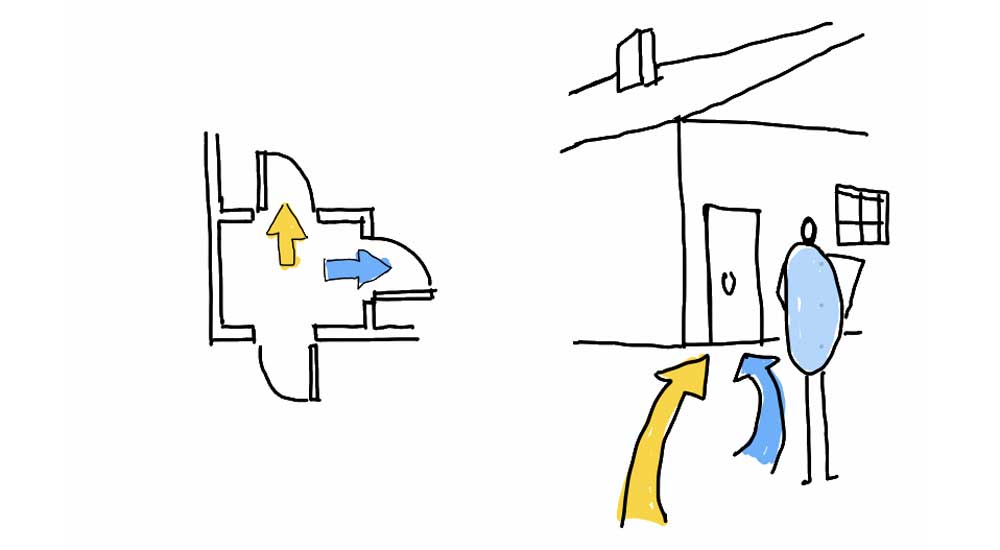This website is a guide and is not intended to replace professional advice. Please see our disclaimer for more information!
Feasibility Check
Vertical Split


These are units built by splitting your house like a semi-detached house to create a new unit. This split could be side to side or front to back. To legally register your unit, there are some specific requirements you will need to meet. The city refers residents to this Ontario website for a detailed guide for checking these requirements. Before you review the information provided by the Ontario website guide, check out our checklist below as a starting point to see if your home is a candidate for this kind of new suite. Remember to verify all code requirements with your local code, or hire a professional to do this for you!
Spatial Requirements
Ensure proper access
How would you split your home?
A vertical split means placing a wall inside your home to separate it into two or more units. This split can be just on one floor, or it can include multiple floors.
There are two ways to split a home:
Option 1 - A front to back split
Option 2. - A side by side split

If you want to make afront to back split, you’ll need to make sure there is access to the back of your home.
You need a minimum of 1m of clear passageway between your house and the edge of your lot for servicing and emergency access to a unit in a garage conversion that is located in the back of your lot.
If your lot backs onto a laneway this can be used as an alternative to the 1m clear pathway from the front yard
You need a minimum of 1m of clear passageway between your house and the edge of your lot for servicing and emergency access to a unit in a garage conversion that is located in the back of your lot.
If your lot backs onto a laneway this can be used as an alternative to the 1m clear pathway from the front yard


Measure the ceiling
Your second unit must have a ceiling height of 2.3m over 75% of the floor area in a living room or space, dining room or space, or kitchen space with a minimum clear height of 2.1m
Measure your ceiling to see if it meets this minimum. If not, it will be expensive to make this change to legally register your unit.

Are there windows?
Natural light is a necessity for housing. If your space already has windows this is a plus!
The size of windows you will need for a unit depends on how big the unit is and what type of room you are in. Some windows may need to be used as an exit (more on this below!) The building code has minimum window sizes for different areas in your unit.
If your window is used for exiting you may need a larger window.
The size of windows you will need for a unit depends on how big the unit is and what type of room you are in. Some windows may need to be used as an exit (more on this below!) The building code has minimum window sizes for different areas in your unit.
- Living room or dining room - 5% of floor area
-
Bedrooms - 2.5% of floor area
- Laundry room, kitchen, bathroom - no windows required.
If your window is used for exiting you may need a larger window.

Getting in and out safely
Access/egress
There are two ways you can provide access to units within your house:
Option 1 - You can provide direct exterior access.
This means each unit has its own fire-separated exit path from the main space of the unit to the exterior. In this case, each unit will have its own exterior ‘front door.’
Option 2 - You can provide access to the exterior through a shared entryway.
This means units will share a ‘front door’ and have a small section of communal space from which they access each of their units.


What kind of access do you have?
Option 1 - Separate second entry
This is a good option because you will not have to do a lot of work to allow access to the unit. This is a door at the main level, often at the side of the house.
This is a good option because you will not have to do a lot of work to allow access to the unit. This is a door at the main level, often at the side of the house.

Option 2 - Share an entry
If you don’t have a separate entry, you can create a shared entry way for both units. You will need to build a wall to separate the shared space from each of the units.
If you don’t have a separate entry, you can create a shared entry way for both units. You will need to build a wall to separate the shared space from each of the units.

Option 3 - New separate entry
This option will require a bit of exterior work. You will need to create a new opening for a new exterior door in the outside of your house to accomodate a separate entry.

You may also need to provide a second exit through a window in your unit that is large enough for a person to get through and easily open without any tools.
Electric, Heating/Air, and Plumbing
Check your utilities
Check your electrical service
Step 1 - Check the existing electrical service on your electrical panel
Find the circuit box. Find the main cut-off switch—this is typically the biggest switch in the box. The cut-off switch often has the number of amps written on it. You will likely need a minimum of 100 amps.
Step 2 - Use the chart below to calculate the existing electrical capacity (Coming soon.)
Step 3 - Check how many units you can add based on the existing electrical capacity. (Coming soon.)
Verify the level of electrical service you will need with a licensed electrical engineer or electrician. n.
Cost considerations
Whenever you are deciding what type of unit to add, it is important to understand what are the major cost considerations. For a vertical split renovation these include:
- unit access
- unit egress
- fire and sounds separation
- new bathroom(s)
- new kitchen(s)
- unit egress
- fire and sounds separation
- new bathroom(s)
- new kitchen(s)
Case study
This vertical split case study involves creating distinct living units by subdividing the existing structure of the house in the vertical axis, meaning multiple units share a floor plate. Interior walls are added to create the necessary rooms within each unit and demising walls are added between units to create necessary fire separations. The project introduces new kitchens and bathrooms for each unit. Major considerations include plumbing, fire separation, and unit access.
Existing Floor Plans



Case Study Floor Plans



THIS WEBSITE, INCLUDING ALL DATA AND INFORMATION INCORPORATED HEREIN, IS BEING PROVIDED FOR INFORMATION PURPOSES ONLY AND IS NOT INTENDED FOR AND HAS NOT BEEN APPROVED FOR USE FOR CONSTRUCTION AT ANY LOCATION.
For certainty, ReHousing (Canada), The University of Toronto, John H. Daniels Faculty of Architecture Landscape and Design, and LGA Architectural Partners provides no representation or warranty regarding any use of or reliance upon this website, including any representation or warranty that this website complies with applicable laws (including any applicable zoning by-laws or building code requirements) and any representation or warranty that any cost estimates included in or based upon this website have been validated by the applicable market. Any use of or reliance upon this website by any person for any purpose shall be at such person’s sole risk and ReHousing (Canada), The University of Toronto, John H. Daniels Faculty of Architecture Landscape and Design, and LGA Architectural Partners shall have no liability or responsibility for any such use of or reliance upon this website by any person for any purpose. Prior to any use of or reliance upon this website by any person for any purpose, consultation with a professional architect duly licensed in the applicable jurisdiction is strongly recommended.
For certainty, ReHousing (Canada), The University of Toronto, John H. Daniels Faculty of Architecture Landscape and Design, and LGA Architectural Partners provides no representation or warranty regarding any use of or reliance upon this website, including any representation or warranty that this website complies with applicable laws (including any applicable zoning by-laws or building code requirements) and any representation or warranty that any cost estimates included in or based upon this website have been validated by the applicable market. Any use of or reliance upon this website by any person for any purpose shall be at such person’s sole risk and ReHousing (Canada), The University of Toronto, John H. Daniels Faculty of Architecture Landscape and Design, and LGA Architectural Partners shall have no liability or responsibility for any such use of or reliance upon this website by any person for any purpose. Prior to any use of or reliance upon this website by any person for any purpose, consultation with a professional architect duly licensed in the applicable jurisdiction is strongly recommended.





